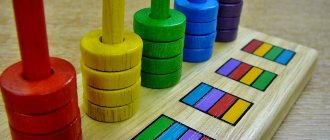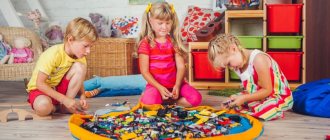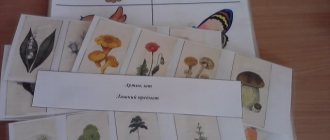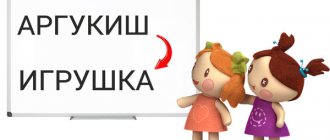10/22/2018 Yulia Shevchenko
General Director of the Perm Center for the Development of Giftedness Yulia Shevchenko took part in a discussion about the engineering thinking of preschoolers at the Leaders of Change forum and spoke about her impressions. We publish her opinion.
— The topic of the discussion in which I was invited to participate was designated “Engineering thinking of preschoolers.” True, there was a subtitle specifying that the conversation should turn towards the developmental effect of robotics and other types of technical activities available to preschoolers, but somehow it immediately focused on an attempt to separate a whole “nest” of concepts, to identify their boundaries, place and right to exist. This is probably correct: it is difficult to talk about the development of something if you are not sure that it exists or do not understand what the essence of this phenomenon is. Another thing is that meaning and essence are not the easiest subject for “podium” discussions, as they are in forum formats.
Engineering thinking - a process or a property?
Let's start with the main question for discussion about the legitimacy of distinguishing and the essence of engineering thinking. In general, thinking allows us to reflect patterns and cause-and-effect relationships. At the same time, two options are not distinguished in verbal form: thinking as a process of reflecting such patterns and thinking as a property that allows a person to reflect such patterns.
Therefore, a few clarifications. Mental processes are the basis of mental activity. Or, one might say, mental activity (the work of the psyche) is realized in mental processes. Mental properties are some stable characteristics by which people can differ from each other. They represent stable characteristics that determine the effectiveness of a particular process in a particular person. The difference between mental processes and properties (and there are also mental states, but we won’t talk about them now) is not always easy to grasp. Understanding is usually facilitated by the use of physiological analogies. Physiology also has processes and their individual characteristics (and states, but we won’t talk about them). Let's take digestion. In general, this is a certain process that is characteristic of everyone, for simplicity, let’s say, people. But if someone says that due to “weak digestion” he is forced to give up a certain product, he is talking about a property that distinguishes him from other people.
Article “Formation of the foundations of engineering thinking in preschool age” article (senior group)
FORMATION OF THE FUNDAMENTALS OF ENGINEERING THINKING IN PRESCHOOL AGE.
Preschool age is a significant period of development of all mental functions: speech, thinking, emotions, mechanisms for controlling voluntary movements, for which the higher structures of the brain are responsible - the cortex. It is at this time that imaginative thinking is formed, and the main means of its formation are visual models and objects of real nature. The first stage of imaginative thinking develops in various types of children's activities - play, design, experimentation.
Thinking as a special mental process has a number of characteristic features. The first such sign is a generalized reflection of reality, since thinking is a reflection of the general in objects and phenomena of the real world and the application of generalizations to individual objects and phenomena. The second, no less important, sign of thinking is indirect cognition of objective reality.
The development of a preschool child’s thinking is ensured by enriching and complicating his practical activities and mastering the methods of mental activity itself.
The most relevant thing in the modern world is the development of preschoolers’ thinking abilities and the ability to think constructively. The formation of constructive thinking begins precisely in preschool age.
One of the most natural and favorite activities for a child is design. Design activities are an effective means of creating and solving problem situations for preschool children.
Nowadays, the technical complexity of means of production is constantly increasing, which requires special attention to the professional intellectual qualities of the engineer, as well as to his creative abilities.
Engineering thinking is understood as a type of cognitive activity, a set of intellectual processes and their results, aimed at research, creation and the need for new high-performance and reliable equipment, automation and mechanization technologies, and improving product quality.
Engineering thinking combines different types of thinking: logical, creative, visual, practical, theoretical, technical. The main types of thinking listed are creative, visual-figurative and technical. All of them begin to form in preschool age.
The “makings” of engineering thinking are necessary for a child from an early age, since from early childhood he is surrounded by technology, electronics and even robots. This type of thinking is necessary for studying technology, “immersing” a child in the technological world (learning from an early age to explore the chain “button - process - result”, instead of teaching a simple and thoughtless “pressing buttons”).
To develop design thinking, it is necessary to create an educational environment in which the child will develop. The group must create conditions for the realization of the capabilities of children prone to scientific, technical and engineering creativity, conditions for the formation of engineering competencies. Different types of construction sets “Polydron”, “Lego”, “Froebel’s Gifts” will allow children to develop fine motor skills, creative thinking, and the ability to solve problems when, for example, parts do not fit together. Kids can build castles, towers, cars, boats and even houses with tunnels to crawl through! Children will have the opportunity to build both large and small structures while mastering the concepts of shapes, 2D and 3D objects, and learn how to work as a team to turn ideas into reality.
At the initial stage, it is necessary to develop the child’s ability to see a problem, the ability to ask questions, the ability to put forward hypotheses, and the ability to define concepts.
A special place in the development of the foundations of engineering thinking is occupied by research activities, during which the ability to systematize, conduct observations or experiments, the ability to draw conclusions, structure material, work with drawings, models, and defend one’s point of view is developed. It is necessary to create conditions for the development of the child’s cognitive activity through the accumulation of his own experience.
The combination of individual and joint forms of construction increases productivity and understanding of methods of activity, which allows children to create meaningful communication. The inclusion of design in various everyday events (holidays, games, entertainment) contributes to the formation of the need and desire to design. Organizing targeted observations of various objects (on the street, in the natural environment) is an important stage for the development of children's plans.
Children, gaining constructive experience, implement their technical solutions, show resourcefulness and ingenuity, experiment, and then improve their buildings. All this is the beginning of technical and then engineering thinking.
The engineering and technical orientation is very relevant in the context of the rapid development of science, technology and production technologies. Engineering education today shapes the economic potential of the country, so it is very important to lay the foundations of engineering thinking in kindergarten.
A modern engineer must process scientific ideas into technology and then into production, and also carry out the sequence “research - design - technology - manufacturing - delivery to the end user - maintenance of operation.” It is possible to raise such a specialist if you start working from childhood. According to scientists, a child who has not become acquainted with the basics of technical activity in preschool age will most often not connect his future profession with technology. Therefore, it is important to identify and develop technical inclinations in preschoolers as early as possible. This will allow us to build a model of education for all ages – from kindergarten students to students.
Preparing children to study technical sciences means teaching and developing technical creativity. This will contribute to the education of active, passionate people with engineering and design thinking. Finding a place in the structure of the educational process of a preschool educational organization (in full compliance with the Federal State Educational Standard for Preschool Education) for teaching the basics of technical sciences will be helped by the introduction of a partial modular educational program for preschool education “From Froebel to a robot: raising future engineers”, the purpose of which is precisely to form in children the prerequisites for readiness to study technical sciences using gaming equipment.
The implementation of this program is possible if an appropriate environment is created. The environment should be content-rich, transformable, multifunctional, variable, accessible and safe. In order to implement the intended principles of organizing a developmental environment, it is necessary to fill it with specific equipment, objects and toys. To familiarize preschoolers with the engineering profession, a special developmental environment is needed. The implementation of the program is a step-by-step work with constructors: the play set “Froebel’s Gifts”; designers; robotics. Friedrich Froebel came up with the first “constructor”, called “Froebel's Gifts”. These six “gifts” are symbolic elements of the Universe, composed of basic geometric shapes: sphere, cube, cylinder. Such subject material allows, according to F. Froebel, to model in a simple form all the diversity of connections and relationships of the natural and spiritual world, to carry out psychological and pedagogical (emotional, speech, etc.) support for adults in children’s activities, which gives meaningfulness to objective actions. During design, there is a continuous combination and interaction of mental and practical actions. Working with a construction set promotes the comprehensive development of preschool children and creates conditions for the formation of the ability to make volitional efforts aimed at achieving results. It also lays the foundations of hard work in a person, where children learn to solve constructive problems, get acquainted with various ways of connecting parts, and create all kinds of movable structures.
Thus, the use of robotics in education contributes to the development of engineering and design abilities of preschool children.
A robot in the educational process is, first of all, an interdisciplinary technical object, the structure and principle of operation of which is the area of application of knowledge of a whole complex of sciences: information on the history of robotics and modern prospects for robotics; the place and role of robotic systems in the modern technical environment, the essence of the concept of “robot”, types of robots, various technical inventions. By creating robots, preschoolers acquire polytechnic concepts and skills, master the prerequisites for technical and technological competencies. Robotics is also a new visual aid that is considered effective for individualizing learning.
Work under the program will allow you to fulfill the goal of supporting professional self-determination at the stage of preschool education - the formation of a primary idea of \u200b\u200bthe world of professions, interest in professional work, positive attitudes towards various types of work and creativity.
Engineering thinking for everyone?
One of the questions that was repeated several times yesterday was whether engineering thinking is inherent in everyone, or is it a gift of a select few (sounded in the context of “is it necessary to work with everyone?”). Here I will use an analogy again. Does everyone have logical thinking? If we consider it as a procedural characteristic, then the answer is clear: of course. Thinking is logical by nature, this is its integral characteristic, but when we say about someone “he has wonderful logical thinking!”, We are pointing to special properties, some property that distinguishes one person from others. Therefore, in practice the concepts of “developed logical thinking”, “weak logical thinking”, etc. are used.
The difficulty with engineering thinking is that the legitimacy of its identification is not so obvious, although this concept has been introduced both into the scientific field and into applied contexts, and of course, for the first time it was not heard in “recent documents from the Department of Education,” as was mentioned yesterday. The need for it arose when it was not possible to explain by the work of other aspects of thinking the possibility of solving problems of a certain type - engineering problems. Let's take a trivial one: you need to pull out a small ball that has rolled into a very narrow gap between the sofa and the floor. If we have an object that looks like a stick, this sets one level of the problem. What if there is no mop, but only sheets of paper, or only a plastic bottle, or, say, only a banana? Relying only on logical, mathematical, or artistic thinking, it is impossible to solve such a problem. And, if we try to imagine, visualize what is happening in our heads when we are looking for a way to cope with this difficulty, most likely we will see something special, similar to diagrams from physics textbooks. Therefore, I personally support the opinion that specific engineering thinking does exist. Different researchers describe the characteristics unique to engineering thinking in different ways. I personally really liked the statement from some relatively recent popular science article that engineering thinking allows you to see structures and act under constraints. I think the article stated that it was from the book Think Like an Engineer. The book doesn't have very good reviews on Ozone, but it looks like I wanted to form my own opinion.
What is engineering thinking?
During the discussion, the opinion was also voiced that engineering thinking is a concept in the same category as “culinary thinking,” “hairdressing thinking,” etc. (sounded in support of the thesis “there is no need to create entities, so you can come up with any kind of thinking”). Well, if someone tells me about a special type of culinary or hairdressing problems that cannot be reduced to mathematical, artistic or engineering, but on the contrary - universal, arising and solved in various types of practical/professional activities, then I will definitely agree that such an “idea” will be good and scientifically substantiated. When it comes to engineering problems that require us to use specific cognitive skills, they are all around us. Engineering thinking may be required if you need to open a jammed lock, get a kitten out of a tree, put on tight shoes without special equipment, iron one sleeve of a shirt without creasing the previous one, attach a bag to an uncomfortable back of a chair at a conference, and so on ad infinitum. Engineering problems are regularly faced by professionals and amateurs in the field of cooking or hairdressing.
It will not be possible to integrate engineering thinking into the series “visual-effective - visual-figurative - verbal-logical”. The concept of “engineering thinking” does not correspond to the concept of “abstract thinking”, where they tried to place it. The relationships between these phenomena are completely different. The fact is that, in essence, visual-effective, visual-figurative and verbal-logical thinking is, rather, not classification categories, but a chain of mental new formations that open up new opportunities for us in the course of development (both individual and evolutionary). The “field of objects” in which we can solve problems of different types is gradually expanding. At first we can solve mental problems only on the basis of manipulating material objects, then by working with images, then by using abstractions. It's the same story with engineering problems. Doesn’t a child who is looking for support, mastering upright walking, or a baby trying to overcome the ingenious mechanisms of “child protection” encounter them? And although visual-effective, visual-figurative and verbal-logical thinking are most often called types, more accurate, in my opinion, is another conceptual construct: thinking at different levels. And then we can talk about engineering thinking, which can be implemented at three different levels. At the same time, it is important not to forget that the transition to a new level does not reduce the significance of previous achievements. After all, any tool must be used rationally. If it is important for us to quickly get the ball out from under the sofa, and we have a mop with a long handle of a suitable diameter at hand, it would be irrational to create a design for a mechanical arm or carry out complex calculations describing the mechanics of the interaction of the mop, the floor, the sofa, the ball and our own body, taking into account the draft and thermal characteristics of the room.
Formation of engineering thinking in preschoolers
Elena Rashitovna Banina
Formation of engineering thinking in preschoolers
Formation of engineering thinking skills in preschool children.
According to the government of the Russian Federation, the field of engineering and technology is the area of greatest deficit in Russian society; all links in the educational chain set themselves the goal of developing these areas of education. Preschool education sets a goal - to form engineering thinking in a child . Namely, to educate a creative person, with creative thinking , capable of navigating the world of high technical equipment and able to independently create new technical forms . What is engineering thinking ? “ ENGINEERING THINKING is a type of cognitive activity aimed at researching, creating and operating new high-performance and reliable equipment, advanced technology, automation and mechanization of production, improving product quality” (according to G. I. Malykh and V. E. Osipov)
.
That is, we can say that mature engineering thinking is the key to success in production for specialists in the technical industry. But this type of thinking is not formed on its own ; there can only be prerequisites for its formation in a particular individual. What, after all, contributes to the formation of engineering thinking in a person ? And the quality of the entire educational process contributes: not only higher, secondary and primary, but also preschool . After all, as we know, preschool education is the first link in the educational chain, on which the foundation of a future personality is laid. Let's understand the essence of human engineering thinking . An engineer’s thinking contains not only data, information, formulas , it is based on the ability to independently build an algorithm of actions and the sequence of manufacturing a product. That is, an engineer is able to mentally predict the result of his activities, relying on well-founded facts, accumulated knowledge, skills and experience. The formula for engineering thinking is as follows : knowledge, skills, experience in professional activities plus the ability to work independently, resourcefulness, ingenuity, creativity, responsibility, the ability to analyze and predict. Engineering thinking is an active form of creative thinking . The formation of engineering thinking is facilitated by setting and solving practical professional problems. engineering sets for itself must be based on universal human interests (ecological, economic, social)
and recognize human life as the highest value.
That is, in order to realize the goal of preschool education in the field of technical creativity - to form engineering thinking in a child . Namely, to educate a creative person, with creative thinking , able to navigate the world of high technical equipment and able to independently create new technical forms , it is necessary to develop a number of basic qualities necessary for a future successful engineer : the ability to combine, reason, establish logical connections; development of attention and concentration; development of creative thinking ; ability to perform independent types of work; humanism. The development of technical thinking is based on humanistic ideas and is focused on creating inventions useful for society. A. Einstein said this about technical creative engineering activity : “This is a range of proportions that prevent you from doing badly and help you do well
.
The engineering thinking of preschoolers is formed on the basis of scientific and technical activities, such as light engineering and other types of construction; rationally, expressed as a product of activity; systematically formed in the process of scientific and technical creativity; tends to spread to all spheres of human life.
Based on these basic principles of engineering thinking of preschoolers , we use the following methods for organizing children’s activities:
— construction using Lego Education, Lego “First Mechanisms”
and Lego WeDo, including elements of robotics for children of older and pre-school age and didactic games using Lego constructors for children of primary preschool
age , including learning to draw up an algorithm for assembling a particular product of activity, and learning to depict the product of activity in three projections;
— design and research activities of children with subsequent presentation of their results at the municipal research conference of young researchers “Litvinov Readings”
;
— experimental activities of children that help solve problem situations in non-standard ways.
The use of these methods of organizing children's activities makes it possible to combine the educational space of family and kindergarten, thereby allowing children to develop engineering thinking not only during educational activities in a preschool institution , but also in free activity both in kindergarten and at home.
At the same time, the formation of basic (starting)
potential competencies and personal qualities of
preschool children are formed by me in the “evolutionary chain”
: I am a researcher, I am a designer, I am a master, I am a creator.
This allows us to start the process of using variable methods and techniques of the teacher, that is, our polypossibilities within the framework of the development of engineering thinking .
So, let's follow the path of the child creator.
I am a researcher.
At this stage, the child ends up in the so-called “Technical Bureau”
.
He examines product samples and develops a perception of the shape , size of the object, and space.
The young researcher, actively using reference diagrams, various symbols and signs of a figurative nature, tries to establish what the object is like and how it differs from others. The child explorer learns to imagine a sample in different spatial positions. I am a designer.
In the "Design Bureau"
work is in full swing to improve the product, the child makes it creative and unique. Initiative, creativity and imagination help the young designer find the positive properties of objects. The use of which will improve and transform the product, making it a discovery of design ideas. This stage is of particular importance for improving knowledge, skills and abilities about a part of the whole, the properties of an object, the concepts of synthesis and analysis.
I am a master.
In a workshop"
the child realizes his experience of creation.
For his craft, the young master completes the Master Case with the necessary materials (natural, waste, or others of your choice)
.
The child-master has his own active position, a wide spectrum for creation: technical or artistic design, the use of Lego, the basics of modeling, prototyping.
In a workshop"
We present the child-master who created the craft with a sticker sign (evidence of his
“point of pride”
). This has a positive effect on his self-esteem and creates motivation to move to the next stage.
I am a creator.
This is a creator, the pinnacle of skill: his portfolio includes design skills, research activities, the ability to establish cause-and-effect relationships, and a unique “handwriting”
masters
The child creates and creates. The product of his activity is part of the surrounding life: he can become the hero of a fairy tale, a story, he can serve as a model for a drawing by a young artist; become the object of gaming, research, and project activities. And like any man-made product, it contributes to the child’s self-expression, the development of his independent creative activity, the desire to create and freedom of choice.
This approach to organizing children's activities makes their development easier, faster and allows them to reach greater heights. In our case, this “height”
is the subsequent
formation and development of engineering thinking in a grown-up child, guiding him along the path of scientific and technical creativity.
Technical creativity or engineering thinking?
Now about the relationship between the concepts of “technical creativity” and “engineering thinking”. It would seem that everything is simple here, but we have to stop at this point, because we ended up facing a funny situation. During the discussion, a completely understandable idea was voiced that thinking is an abstract thing, it is easier to discuss what can be seen and touched - technical creativity. I remembered: “And the head is a dark object and cannot be examined.” You can’t argue: creativity is indeed easier to discuss. And after the meeting ended, we read the following response on the feedback board: “in the end, I realized that young children cannot have engineering thinking, but only technical creativity”... I hope the author of the response will read this note, including the following thesis. Creativity is an activity. During its course, various mental manifestations are involved: sensations, perception, attention, memory, imagination, emotions, will and, of course, thinking of different types and different levels. The leading type of thinking in most cases will be determined by the nature of creative activity, but will not always be limited to it. For example, engineering thinking can be involved in the process of artistic creativity: for example, when creating many sculptures, complex engineering problems are solved. It could probably be the other way around: but I haven’t come up with a beautiful and obvious example yet.
Since we have already started to understand, let’s try to separate all the concepts of this field. How are thinking and intelligence related? If thinking is fundamentally procedural, then intelligence is a quality, a property in its pure form. Moreover, in contrast to “good/lively/fast/accurate thinking” (which, as we said above, is also a property), intelligence is a more complex property: its content contains not only the speed and efficiency of cognitive operations, but also other characteristics (this “filling” is described differently by different concepts of intelligence). It is likely that engineering intelligence and engineering thinking are related in a similar way.
How to develop engineering thinking in a child
Engineering professions are called one of the most in demand in the future. Special projects and master classes help a child develop engineering thinking at an early age and develop the necessary competencies in the field of design and scientific creativity. In particular, dedicated to architectural engineering. Project leaders tell us how to instill an interest in architecture and teach you to think like an engineer. By the way, parents can also try their hand at engineering together with their children.
Useful Mela newsletter twice a week: Tuesday and Friday
SUBSCRIBE
Project “Moscow through the eyes of engineers”
These are not only excursions and lectures about the city's architectural monuments and their engineering features, but also children's master classes about how the city works from an engineer's point of view. Children use them to build large structures and at the same time gain skills in design work and an engineering way of thinking.
“I studied to be a civil engineer,” says project leader Airat Bagautdinov. “Unfortunately, today teenagers enter this profession who have no desire to change the world, create something fundamentally new, or make breakthroughs in engineering. But in order for our cities to change, and at the same time our lives to change and become better, such a desire is simply necessary! Therefore, I wanted to change the situation, to prove that it is also possible and necessary to make breakthroughs in construction engineering, to come up with new materials, designs and technologies. To do this, it is necessary to give children a positive perception of the profession of a civil engineer, to inspire them at an age when they, perhaps, are still subconsciously choosing their future profession.”
At the family master classes “I’m my mother’s engineer: we’re building the Shukhov Tower,” children are taught design and the basics of modeling.
In five lessons, a child learns to develop a prototype, cut a model using a laser cutter, and assemble a large structure from parts.
“All the structures are working, these are mini-Shukhov towers and bridges. When teenagers create something big with their own hands that also works, it impresses them. We try to simulate the entire engineering process as much as possible, starting with the study of theory. Thus, children get an idea of how adult engineers work,” explains Airat Bagautdinov. “We try to convey to them the idea that even if they do not become engineers, the approaches and principles that engineers use in their work are universal in any profession.”
According to him, children and their parents come to the master classes “Moscow through the eyes of an engineer” to learn design thinking, teamwork, and making. “We are trying not only to popularize the engineering profession, but also to show that the principles of construction engineering can be applied in various areas of life. That any design does not appear immediately, it is preceded by step-by-step work, when it is necessary to be able to organize tasks and move towards the goal.”
More details
MindWood Project
The creators of the project propose to develop children's logical and creative thinking, as well as teach them architectural engineering by playing with a magnetic wooden construction set. “If children are not disturbed, but only guided, then they themselves find solutions to problems, and sometimes very non-standard ones,” notes the MindWood website.
The project engineers developed three small sets of construction sets (“House”, “Mill” and “Cube”) and one set with a large number of parts (“Bridge”).
You can also assemble other forms according to the principle: first, the abstract frame is assembled. Then you can insert walls, facades, and other flat panels into it. The parts are connected to each other using magnets
“Thanks to magnetic connections, many laws of physics can be tested in practice. For example, there are permissible loads that magnets can withstand. If they are exceeded, the connections are broken,” explains project leader Vladimir Krasyuk. “We built the Bridge construction set using this principle. Thanks to this approach, you can immediately see where mistakes were made during the design.”
The “Bridge” construction set not only develops engineering thinking in children, but also introduces them to the simplest architectural units and connections. For example, with structures such as a farm. “They understand what the load is and how it is distributed. If the farm is two-tiered, children conduct experiments and remove beams. And they understand why the structure does not collapse,” says Vladimir Krasyuk.
Feedback from parents is positive. According to them, after classes, children perceive urban buildings differently, understanding on what principles these structures are based and how they are built. “For example, they look at the ceiling in a shopping center, see triangles and know that these are farms, and can explain to their parents how these structures work,” adds Vladimir Krasyuk.
Today, several teachers involved in the project conduct regular master classes based on the “Bridge” construction set at the “Robostation” at VDNKh in Moscow. “We also come to secondary schools. After all, our master classes can be devoted not only to engineering, but also to other sciences. The parts stick well on a magnetic marker board, allowing the construction kits to be included in various educational methods and systems, for example, Montessori,” said Vladimir Krasyuk.
More details
Isobryulo project
These are lectures, master classes and workshops where participants are told about inventions and inventions, about building modular systems, about design and technology trends, develop creative thinking, and teach effective methods for working on projects and new technologies. At each lesson you can make your own technological souvenir.
“Izobryulo was created as a design bureau, an organization that implements ideas,” says project leader Ilya Sobol. — For this we have research, production and educational blocks. I have always been interested, for example, in ways to reduce the cost of production. Therefore, our approach to any process or object as a designer is to create a unification and optimization model so that it is possible to save on production, but ultimately obtain a unique product.”
Unlike most educational projects, in Izobrulo the educational direction is carried out with the help of partner companies. Typically these are large technology companies that have a need to train their employees or loyal audience in new competencies. People get to classes through internal corporate programs and announcements, rather than through open registration.
Master classes teach people to work with ideas, understand what it means to implement a project, what mechanisms and technologies are available for this, how to interact with other participants, understand who is a competitor and who is a friend. “This is necessary in order to comply with the new reality, keep up with the future, and feel comfortable in the new world that will come or for some has already come,” explains Ilya Sobol.
A person of the future will have to master not a profession, but several basic competencies. Moreover, some competencies should be common to everyone
“People will have to be able to program just as they have to know English today,” says Ilya Sobol. “Right now, working with materials and prototyping is considered the domain of industrial designers and specialists, but after a while most people will need to be able to use personal digital manufacturing equipment, 3D printers and implement their own ideas, rather than wait for others to do it.”
More details
Abilities and giftedness
In addition, there is also the concept of engineering abilities. In general, abilities and talent characterize a person from the point of view of his ability to achieve success in general intellectual or in some specific activity. At the same time, according to Teplov’s clarification, abilities should not be reduced to knowledge, skills and abilities. Abilities are some private, specific properties. These may be, for example, characteristics of mental processes that have become individual characteristics (good logical thinking, vivid imagination, stable attention, a special angle of perception (“I’m an artist, I see this”), or there may be some qualities that are largely determined by physiologically: hearing, sense of rhythm, eye. Talent, according to the sources that have received the most recognition, is an integral phenomenon, the important components of which are the cognitive component, creativity and motivation. Thus, high engineering intelligence or “good” engineering thinking is part of the content of a special type special talent.
Engineering or technical?
It seems that I described all the concepts that I wanted... and now I admit: for me, there remains one difficulty in this whole concept: to clarify which adjective is more correct in the names of all these cognitive phenomena: after all, “engineering” or still “technical”. It’s good that we didn’t get to this issue yesterday.
And, to finish with the psychological issues raised yesterday, I can’t resist and quickly refute a number of theses that were voiced at the event. In fact, there is no scientific data that reliably proves that the possibilities for the manifestation of engineering thinking, intelligence, abilities, or the potential for achieving success in technical activities are limited by temperamental characteristics, the organization of the work of the cerebral hemispheres, or gender-related characteristics of human psychophysiology.
I will only add that insofar as it did not concern essential issues, the discussion, in my opinion, turned out to be complete and was quite successful: we lagged behind different positions, found common ground, were emotional, caring and ready for mutual understanding. For all this, thanks to the organizers, fellow speakers, moderator, experts and all participants!
Photo: Legopolis kindergarten.






